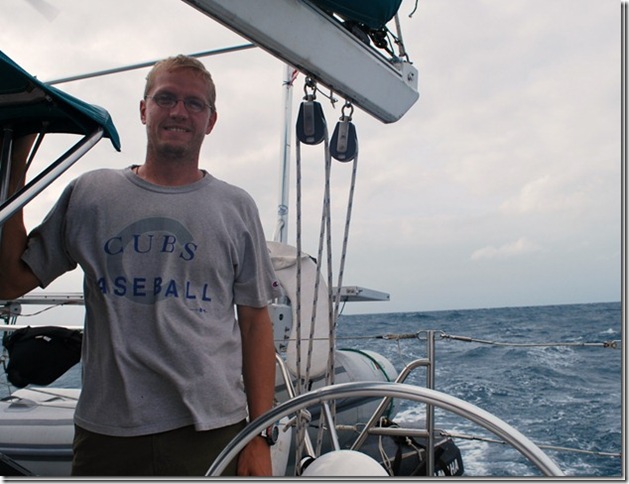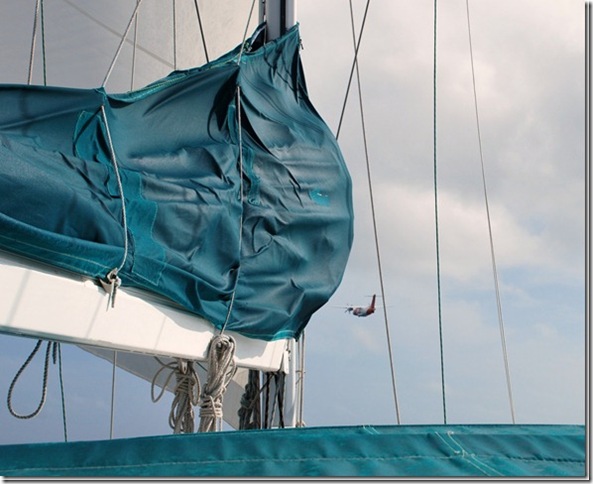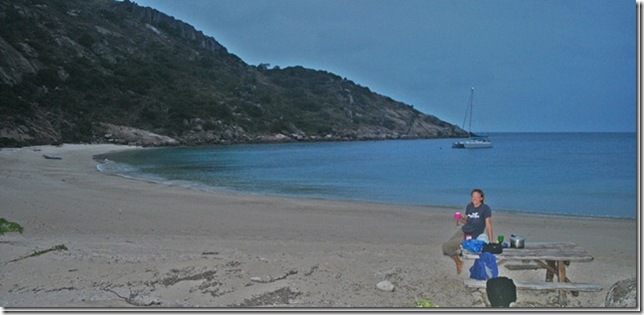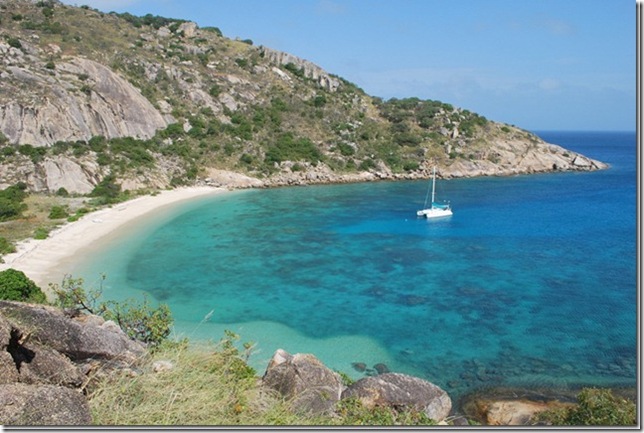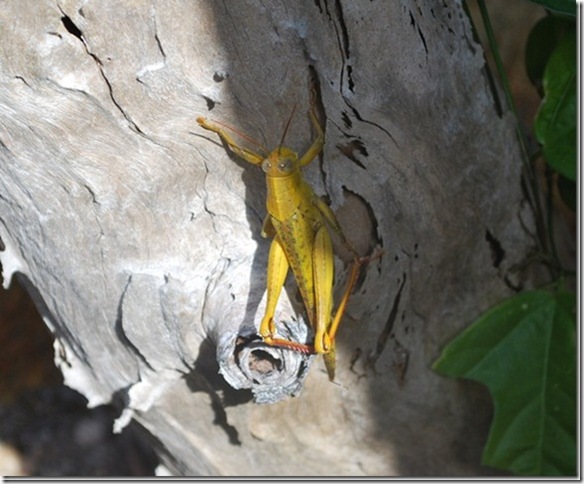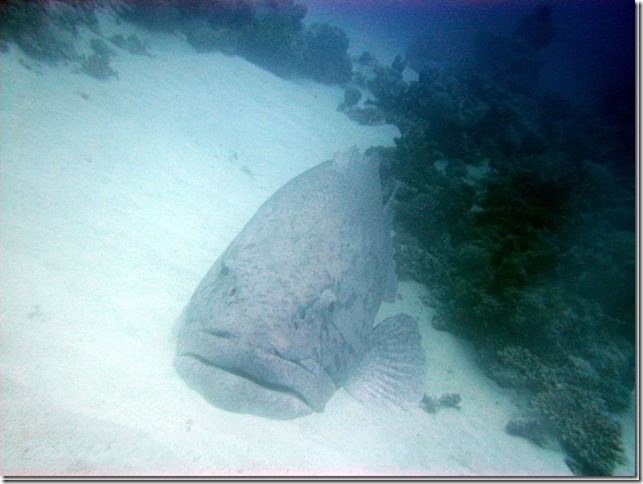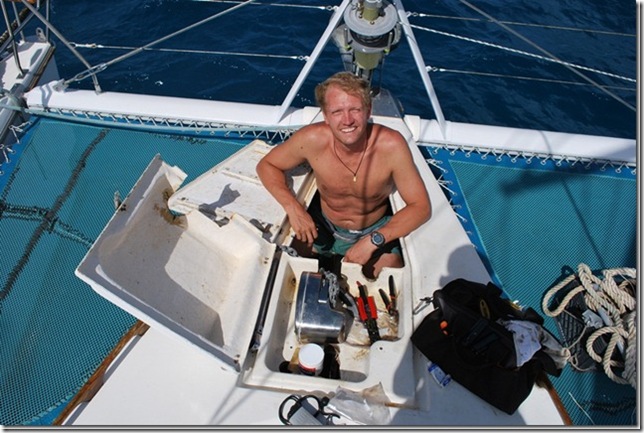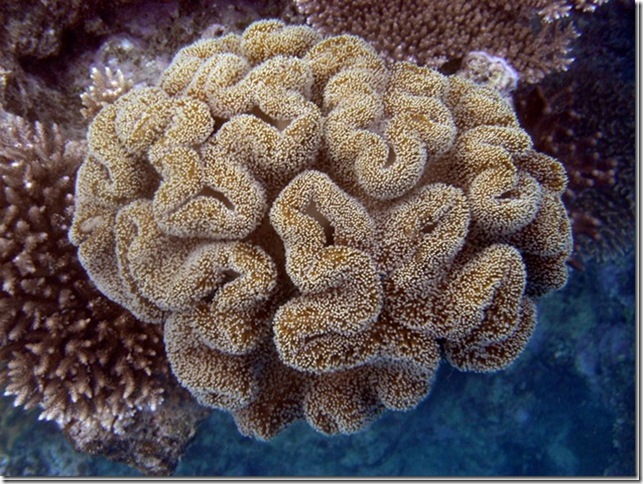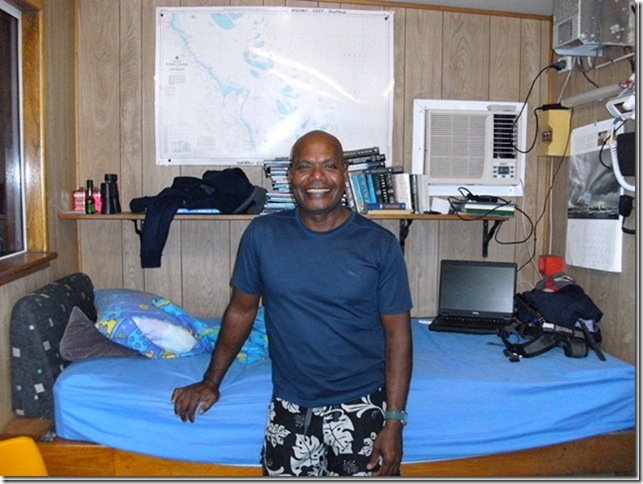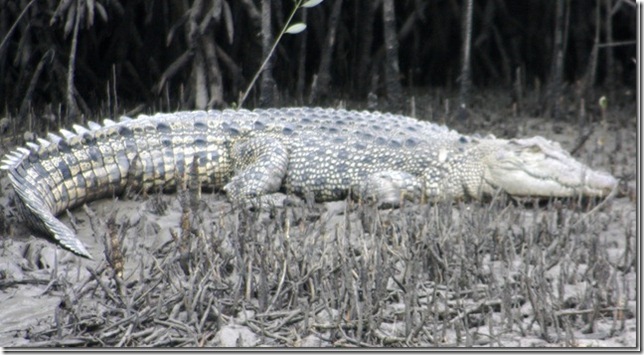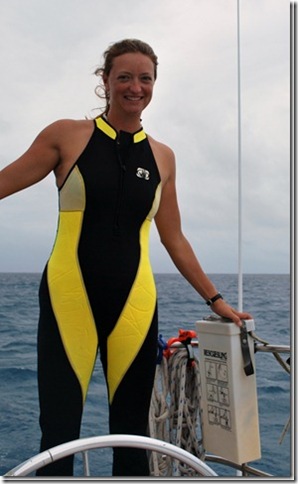Lat: 12 48.453′ S
Long: 143 38.136′ E
It’s about midnight on Sunday, and the half moon has just now made an appearance. I’m relieved to see its glow as it was getting a little spooky knowing that there were reefs on either side of us but seeing nothing but a few hazard lights that appeared deceptively close. I trust the charts for this area, but in the pitch black of darkness, it’s easy for one’s mind to start to wonder about the chances of running across reef that isn’t marked… It doesn’t help that earlier today I noticed a stripe of green water running parallel to our course, indicating that there was shallow water there even though this wasn’t suggested on the chart. (Dallas noticed the same phenomenon an hour or so later and thinks it’s an effect of the sunlight.) To top it off, we are in a shipping channel and have had multiple 850′ container ships pass by us at 15-20 knots — the force at which they could hit us is another fun thing to ponder in case we start to get bored!
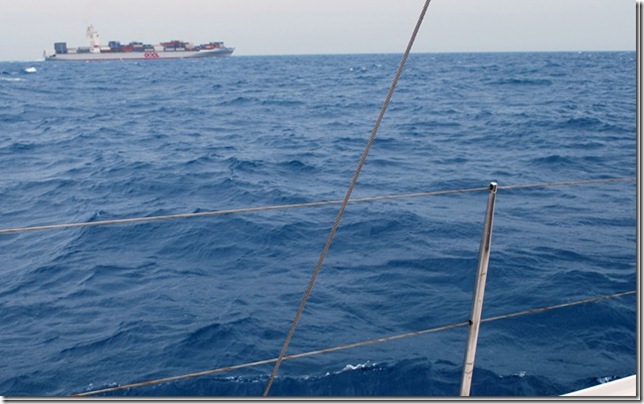 This 600-footer was less than half a mile away
This 600-footer was less than half a mile away
Cruising along the coast (and especially here in the GBR) definitely requires more alertness and maneuvering than our typical set-it-and-forget-it style of open ocean sailing, and I appreciate the challenge. The only annoying part is that our depth meter is set to sound an alarm when we cross above or below the 100′ mark, and since we are in relatively shallow contours near the reef, we have crossed that mark at least 100 times today! Dallas tried to change the settings on the alarm, but the button required to do so isn’t working, so in the meantime, we are getting a bit of exercise walking back and forth to press the offset button.
All in all, it has been a quiet, relaxing day, as seems to be the norm with just the two of us on board. I cut Dallas’ hair in the cockpit this morning, and it looks pretty good if I do say so myself. We had planned on taking a bath in our private bay before setting sail, but the research divers were already here and in the water by 7:30, so instead of flashing them we waited until we were offshore to shower. I went for the saltwater bucket shower (followed by freshwater rinse), while Dallas went freshwater only from the bug sprayer. It’s a matter of personal preference of course, but for me and my long hair it is better to have enough water to get really soaked. My favorite method is still getting in the water and being dragged behind the boat while holding on to the swim ladder, but even with my sailor arms (so I’m told) I wasn’t going to try to hold on while going 6 knots.
We’ve been averaging 6-7 knots with winds from astern and hardly feel it. We had talked about making a short (about 150 mile) passage to start with but both agree that we might as well carry on to Cape York (the northernmost point of Oz) for a quick stop since the wind and seas are treating us well. We will probably also make Darwin a short stop in order to spend more time in Indonesia. Dallas has been reading about Bali and Lombok and getting excited about how cheap everything is there — meals for 2 for $11, hotels for only $7/night! At this point, we are in agreement that we should spend our time there instead of spending a week or two traveling through the Outback, as he says, "to see a rock" (Uluru or Ayers Rock in the center of Oz). We (and cruisers in general) are suckers for cheap food and entertainment. However, we’re not done with Oz yet, and I’m still hoping to see some good ol’ Aussie sights like kangaroos as well as less touristy sights such as the Aboriginal villages up in the Northern Territory.
I’m finishing this on Monday morning. (In the meantime, I got a bit of sleep and watched "The Holiday"–cute!) We just got buzzed by the Australian Customs’ plane. They performed two flyovers, getting about 100′ feet from the boat before calling on the radio to ask us a few questions about the boat, our last/next port of entry, etc. We’d already heard from other cruisers that these flyovers were common here, though, so we’re not feeling too special. They seem to cover all their bases in protecting these waters.
Getting buzzed
Lat: 14 38.846′ S
Lon: 145 27.253′ E
I guess Lizard Island isn’t technically part of the GBR, but it’s here in the middle of it and our beautiful mooring spot in Mermaid Bay is surrounded by coral and marine life. Last night’s dinner was a bit of an adventure. There are actually two picnic tables on the beach here – one in the middle of the beach and one at the left side of the beach at the base of a rocky cliff. I set dinner up as a picnic and we paddled ashore just before sunset. Right after taking pictures of our beautiful, private dinner on the beach and pouring a couple glasses of wine to go with the pasta and garlic bread it started raining. We’re used to this sort of thing, so into the waterproof bag went the camera, etc. and we headed for the dinghy. Right as we got to the dinghy the rain stopped and we decided to give it a second try. We were able to finish dinner and enjoy a nice evening with only light sprinkles. It’s been rainy and windy much of the time here in Australia, but I guess the good side is that in addition to having to work during the week, the weather has kept a lot of the locals ashore and we’ve had some great spots to ourselves. Nobody else has even tried to pick up one of the public moorings we’ve been using.
This morning we made plans to hike up both of the ridges on either side of the bay. The east ridge offered a good chance for pics of the boat with the sun behind us so we headed that way first. We changed from bare feet to sock and shoes (there was no trail so we consented to give the flip-flops the day off) on some rocks at the edge of the water, and I promptly slipped off of the first rock I stepped on and got both shoes soaked. Great start. The climb up the first ridge was slow and a little steep, but not too difficult. I kept thinking of all the bad things in Australia that you could suddenly come across, but hoped that an offshore island is a bit safer. We stayed on the large rocks as much as possible, but had to walk up through the grass at times as well. The grass wasn’t tall, but it was so thick that you couldn’t see what was underneath; only after stepping down on it did you learn whether it was a rock, a hole, or loose hillside. A slow 15 minutes or so of climbing put us at the top of the ridge where we could see a group of tourists being dropped off on the beach below. They all donned wetsuits and were obviously enjoying the snorkeling. The view down to the small bay was beautiful enough to make the Australia month of next year’s calendar.
We’re still in the midst of places that Captain Cook visited, including the nearby mainland town of Cooktown. His ship, the Endeavour, wandered into the maze of reef that make up the GBR and was nearly lost. After running aground on on a reef (remember there were no charts to reference), they were lucky enough to work their way off and limp up the newly christened Endeavour River to a spot that became Cooktown. When they were ready to leave, Cook sailed to Lizard Island and climbed the peak here to sight out a pass through the GBR and into the open water of the Coral Sea.
We tramped back down the ridgeline, along the rocky waterline, across the beach, and over to the western ridge. We were really wanting some exercise after several days aboard, but we were also hoping to get a view of the other side of the island. After climbing over the large rocks along the waterline, we rounded the point and realized that seeing the other side of the island was going to be more work than we’d thought, so we turned back after taking some pics of a really colorful bird that looked a bit like a kingfisher or woodpecker. All along the walk we kept startling really big grasshoppers. Anyone that’s ever been around large grasshoppers knows they can jump and fly, but don’t really seem to navigate all that well. Once or twice they actually ended up flying into us while presumably trying to get away.
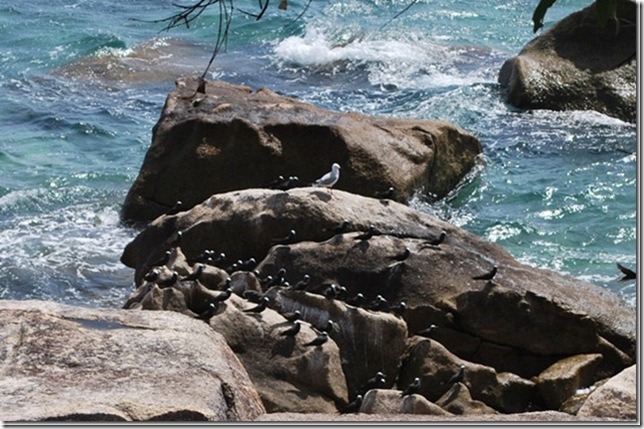 Seabirds taking a break from fishing
Seabirds taking a break from fishing
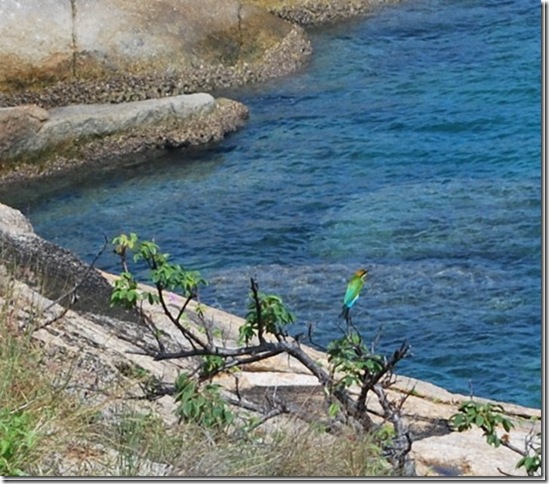 One of the more colorful birds we’ve seen
One of the more colorful birds we’ve seen
Back on the beach we had a short chat with the tourist family, which happened to be Americans from Annapolis, and headed back to the boat for lunch and a pre-dive nap. The diving and snorkeling was supposed to be great here, but whether it’s my general dislike for being wet, diving fatigue, or just plain laziness, I didn’t really feel up for it. Luckily Lauren isn’t one to miss a dive opportunity so we eventually suited up and started swimming over to the reef that juts out off of the rocky eastern point of the bay. The plan was to swim around the reef over to the open water side where we expected to find a wall, and I hoped to find a healthy collection of fish (quite a few birds were fishing this region of the channel when we came in). The dive started out completely unspectacular – small fish we were familiar with, lots of dead and brown coral. Just as we rounded the corner of the reef, though, things started to pick up. We saw a small stingray, a 4-foot white-tip shark and a really big angelfish. The coral became more colorful, plentiful, and much larger. We came across a sort of sandy road that seemed to offer a shortcut to the open water side of the reef, so we followed it and before long came across a 5-foot white-tip shark. This one was sleeping on the bottom and didn’t even budge as we got as close as we felt comfortable (25 feet or so) to take a couple pictures. Not much farther along, a narrow chasm offered a look into deep water beyond. I stuck my head in and the current swept me back, but I could see some amazingly colorful and large fish, so I motioned for Lauren to lead the way since she had the camera. Once we made it through we were in a different world. The fish that were waiting for us are in our dive atlas as “Indian Ocean Sweetlips” and were nearly 2 feet long. I’d been flipping through the book today, seen the picture, and said to myself, “Well, there’s one colorful fish I don’t think we’ve ever seen,” and like magic here they were. We turned the corner and were amazed by the collection of large fish, including a large potato cod, a really big Napolean/Maori/Humphead Wrasse (you’ve gotta google a pic of one to really appreciate how large and interesting-looking they are) and several large schools of big fish. It was like swimming through a tropical fish tank with a gorgeous, vibrant wall of coral to our left. We ended up spending 50 minutes underwater; what started as a ho-hum dive had turned into one of our favorites. This time, the underwater camera lens didn’t fog up, so Lauren’s pics turned out really well, including the video of the “Indian Ocean Sweetlips” (someday we’ll be back to the land of internet again and you’ll see what we’re talking about).
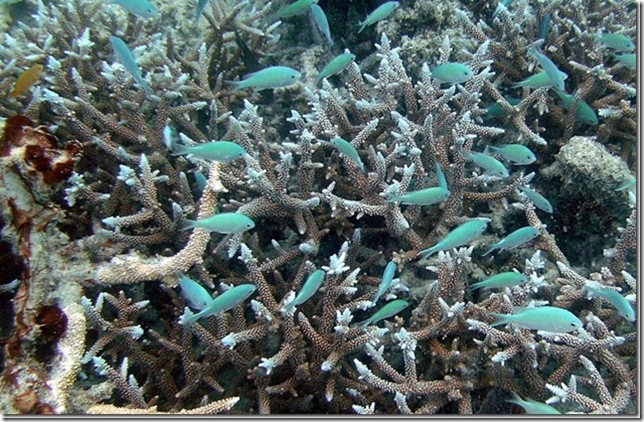 Small colorful fish in the staghorn coral
Small colorful fish in the staghorn coral
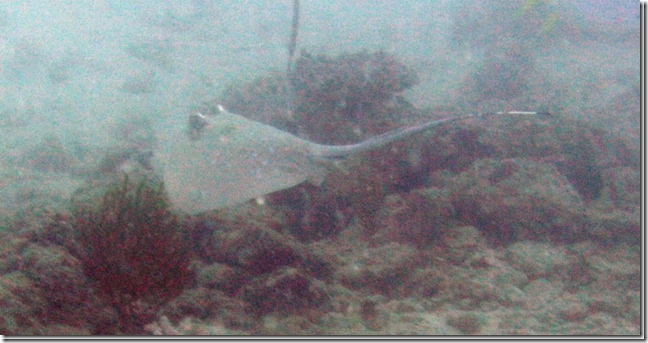 I just can’t see a stingray anymore without having “Steve Irwin” flash into my head
I just can’t see a stingray anymore without having “Steve Irwin” flash into my head
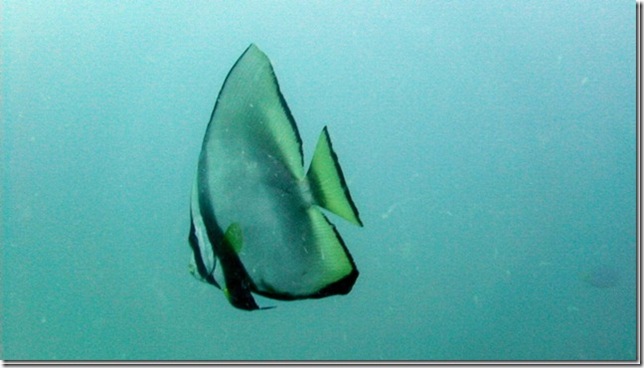
Large angelfish
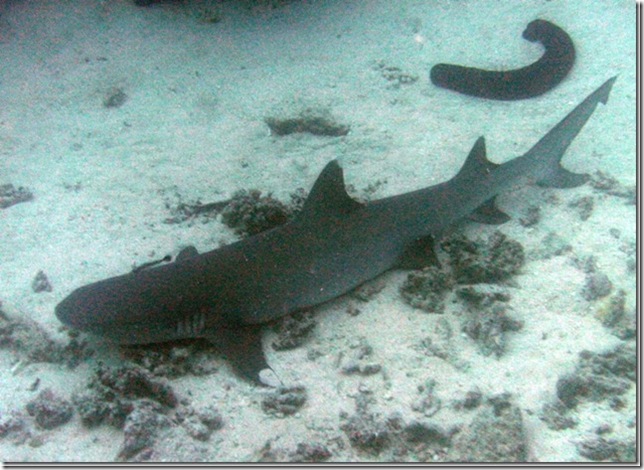 Dozing 5-foot shark and sea cucumber
Dozing 5-foot shark and sea cucumber
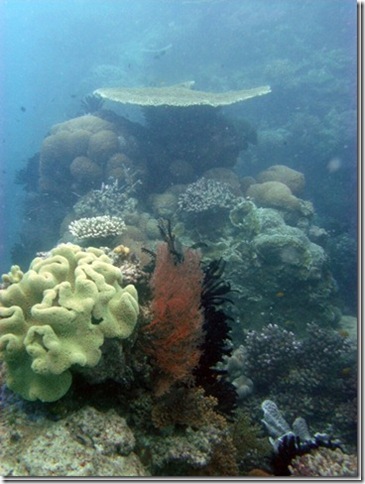 Beautiful coral near the chasm
Beautiful coral near the chasm 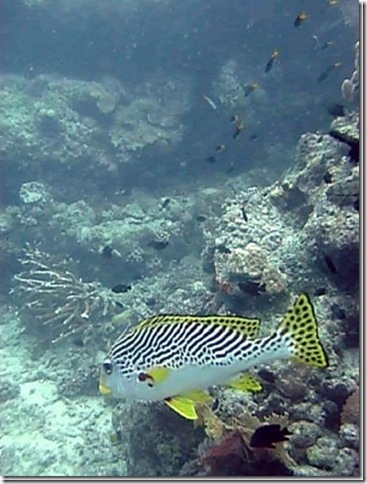 Sweetlips
Sweetlips
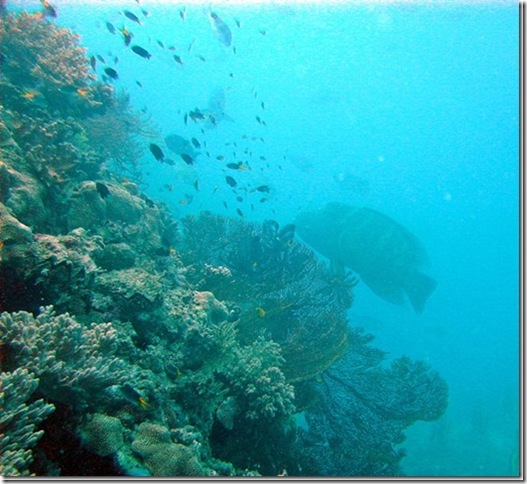 Outer reef wall with large Napolean wrasse
Outer reef wall with large Napolean wrasse
I also got another opportunity to practice navigating underwater with the compass. So far it’s worked reasonably well. I generally start out with some bearings above water and a general idea of what the underwater topology should be like (deep water to the east, etc.), then keep track of underwater landmarks and our compass heading during the dive. We usually don’t have to factor drift into the navigation, but the strength and direction of the current is a factor in terms of the route we take and how much air we save for the return trip. The fun starts when we get to around 1500 psi (out of a beginning 3000 or so) and want to get back to where we dropped down with more than 500 psi. Just like any hike, the journey back seems to go much faster as long as it’s not into the current. We’re also lucky that Lauren uses less air than anyone I’ve ever met, so I usually just have to manage my own air. It’s going to be interesting when we actually do a dive with a divemaster and commercial dive operation again and we don’t have to worry about all that stuff.
When we got back to the boat, I used the air I had left to change the sacrificial zinc on the starboard shaft, which had come loose. The zinc keeps the stray electrical current in the water from eating away the bronze prop and stainless shaft. The zinc is shaped short of like a symmetric egg with a 1” hole through middle that is then cut in half. You fit the halves over the 1” prop shaft and tighten it down with a couple of bolts. Zincs are usually $30 in NZ, but we got some from a foundry for only $10. The funny part is that zinc is zinc, so it seemed like a good deal, but the $30 ones have several features that keep them attached better – they have a couple of embedded copper balls to make good contact with the shaft, captive nuts and retaining washers for the bolts so you don’t drop either of them underwater, and lock washers so that the bolts stay tight with all the shaft vibration and rotation. I’m not sure that a couple extra washers are worth $20, but it’s much easier to hold two captive halves and an allen wrench down there instead of dealing with the wrench, two zinc halves, and two loose bolts with nuts. Anyway, for the want of a couple of lock washers the $10 zinc came loose so we now have a $30 zinc.
Even though only 5% of the GBR is completely protected, it really does seem to make a big difference in the quantity, size, and diver-friendly nature of the marine life. Each part of the reef is zoned (or unzoned) for a wide variety of uses ranging from all activities allowed to marine reserves where no sort of fishing or spearfishing is allowed. Maps of the GBR zoning for the area are free and are mandatory aboard all vessels in the GBR area.
We decided to stay put tonight and get one more night of good sleep before heading farther north toward Cape York tomorrow. Being near land at night does give us a chance to hear the sounds of some of the Australian bird life. There’s one noise that we’re assuming is a bird that’s unlike anything we’ve ever heard. I won’t even try to describe it, but it’s odd enough that you could easily imagine it being some sort of strange owl or mammal.
Lat: 14 38.846′ S
Lon: 145 27.253′ E
Well, this place is nothing short of amazing. As Dallas mentioned, the snorkeling at Normans was the best yet, and the scuba dive today was definitely among our top 5. Before I get to that, let me mention what it was like getting from point A to B.
We had a lazy morning yesterday as we let a couple of squalls pass by. By the time we left the mooring, the sun was shining and our spirits were high as we began to sail north. Our destination was the Cod Hole dive site about 110 miles away, and we decided to sail offshore rather than stay inside the reef to save time. Perhaps we would have decided differently if we had anticipated the 10′ seas and 40 knot winds that were awaiting us offshore, but probably not. We’re experienced now, and it takes more than that to scare us off. However, it takes less than that to make us uncomfortable, and we were both lethargic again. I managed to make some chili and felt much better after eating. (Dallas didn’t, but he liked the chili so much that he had some again for breakfast! Eew!) We listened to an audio book since we didn’t feel like reading, and before long, Dallas was in his usual state of slumber.
I was enjoying myself listening to music and didn’t wake him until quite late. Then it was my turn to pass out. Around 3:30, he awoke me for my watch and let me know that we were just a few miles from the reef but didn’t want to turn into it until daylight. I took this under advisement, pleased that he trusted me at the helm in such conditions, but I was pretty tired and didn’t reef the jib as soon as I should have. By the time I did, we were parallel to our destination, it was still dark, and we were still going 8 knots on only half of the jib! No harm done, though. We just had to tack back into the reef once the sun came up using only a quarter of the jib.
In such strong winds, it came as no surprise that the public mooring was available. It was kind of comical to be picking up a mooring so close to the reef in 40 knot winds, but we did it and eventually mustered up the energy to get our scuba gear on and take a look. According to our dive atlas, the Cod Hole is the "signature dive" of the GBR and is well known for large potato cod that are used to being fed and will bite at and possibly choke on your gloves if you have them on. The atlas advised not to wear gloves for this reason, but Dallas was not having that. He was not about to lose a finger to a cod just so that it would not choke on his glove!
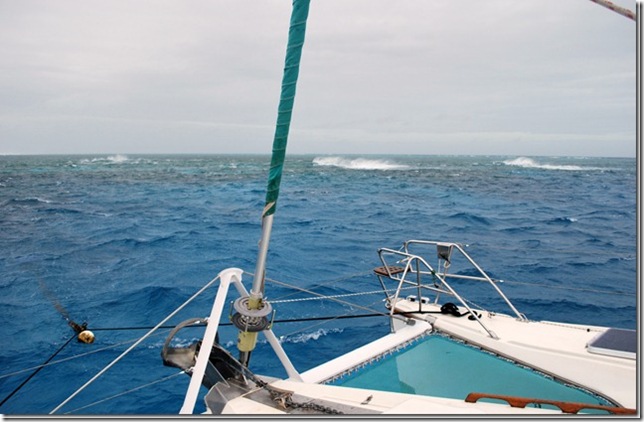 Moored along the edge of the reef
Moored along the edge of the reef
As it turned out, we saw a few of the large buggers, and it was obvious that they are used to being fed. One of largest ones (probably 4′ long and 200 pounds) was stalking us for quite a while and was not even phased by a gentle kick to the head from Dallas’ fin. Watching the way that Dallas kept his hands concealed under his arms when Mr. Potato Head was around had me cracking up. I’ve never laughed so hard into my regulator!
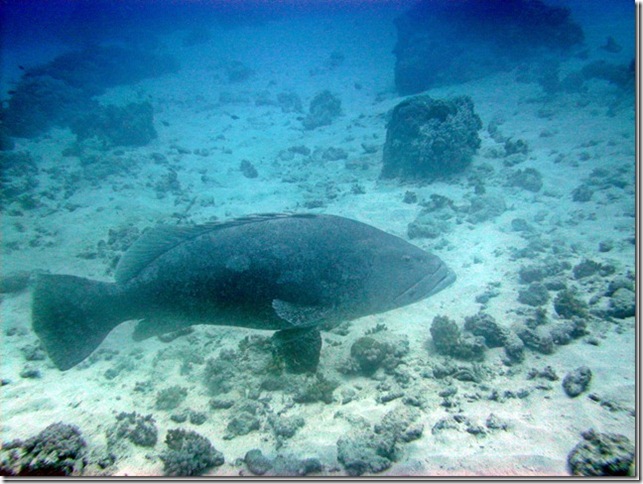 Turns out that the lens was fogged up, but you get the idea
Turns out that the lens was fogged up, but you get the idea
Besides the cod, there was an abundance of other marine life. Instead of there being one large "bommie" (coral head) like we dove on yesterday, it was just a patch of one after another, and each of them had gorgeous coral of all shapes and pastel colors and a healthy supply of fish. They were only 15-20′ underwater, so the visibility was great, and we had a nice, long dive. There were so many coral heads that I lost Dallas at one point, and it felt like we were playing Hide and Seek underwater. Dallas was off taking pictures at the time and was able to capture some nice ones that we will post when we can, probably from Darwin. (For the record, Dallas reminds me that the reason we became separated is because we came around a corner, and I got surprised by a Potato Head that was awaiting and darted off in front of it.)
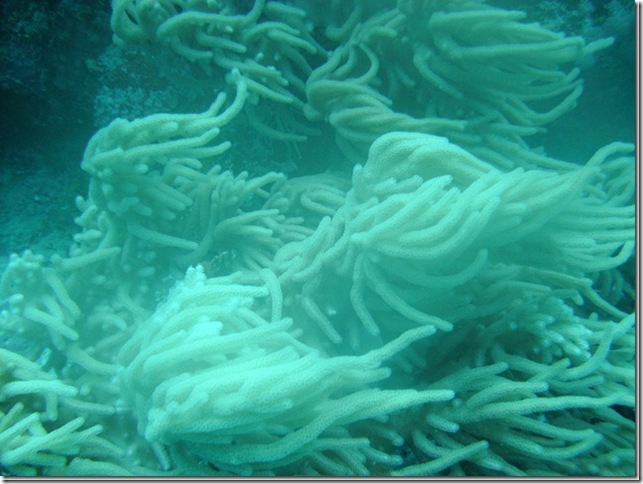 One of the many varieties of soft coral
One of the many varieties of soft coral
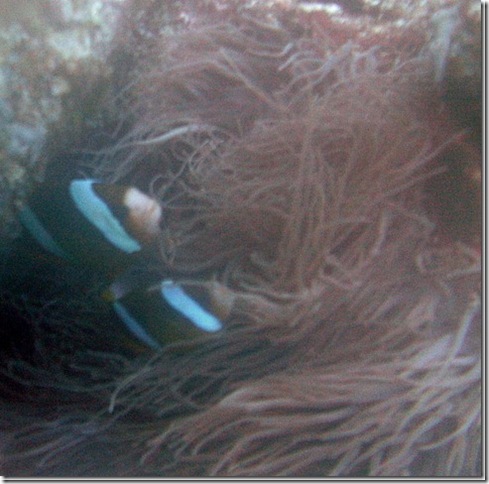 The clown anemone fish hanging out in their host anemone
The clown anemone fish hanging out in their host anemone
From Cod Hole, we sailed 15 miles to Lizard Island and now find ourselves in a beautiful little bay full of bommies with a white sandy beach. We are getting ready to head ashore for a great view and a romantic dinner. Did I mention we have the bay and beach all to ourselves?
Dallas is preparing to make some pasta for dinner. He just needs to know: 1) where the pressure cooker is stored, 2) how much water to put in, 3) where the pasta is located, 4) how much pasta to use, and 5) which sauce to use! (For the record, he decided to make his own sauce.) Each day aboard Pura Vida is an opportunity for learning something new. ;-)
Lat: 16 25.886′ S
Lon: 145 59.209′ E
Our first full day on the Great Barrier Reef (GBR) started with something new — sunny skies. There was still plenty of wind, but at least it was pleasant and warm outside with the colors of the reef much more visible than the day before.
We’d planned to start the day with an early dive, but decided instead to try to fix the windlass, which would be pretty useful if we needed to leave the public mooring and anchor (our allowed time on the public mooring was up at 9am, but nobody had come to claim it). This type of problem is usually wiring, but after all the wiring and the remote checked out, I had a bit of a sinking feeling; the problem was the windlass itself. The windlass didn’t do anything at all, so it had to be some sort of electrical or motor problem. I’d never worked on a windlass or electric motor before, but the windlass is a really useful piece of gear (without it we’d have to pull the chain and anchor in by hand), so I thought I’d give it a shot. With the help of the windlass manual and of course Nigel Calder’s book I was able to get the motor removed and disassembled and determine that two of the four brushes were stuck in their guides. Watching the autopilot servicing the other day was actually pretty useful, as many of the steps were similar. After removing the armature, cleaning the commutator, and freeing the stuck brushes the motor seemed to be working just fine. It took about 5 hours, but by 2pm everything was back together and seemed to be working just fine.
Four hours later it’s almost all back together. Now if I could just get a haircut…
Next it was time to actually enjoy the reef. Norman Reef is a heavily visited tourist destination. There are numerous dive sites and moorings and there’s even a large pontoon, a two-story covered platform roughly 50′ wide and 250′ long. There’s also a floating helicopter pad and a boat with a 10′ deep glass-walled underwater reef-viewing chamber. We headed over to the pontoon where we’d read there was a large Maori wrasse named Wally that was friendly with the divers who feed him. Unfortunately the day boat that brings 200-300 people at a time to the pontoon was there and they asked us to come back later when they’d left, so we dinghied over to a nearby mooring and snorkeled a couple of large reef structures.
 (L-R) Sub/boat, helicopter pad, ferry to the chopper pad, and day-boat tied to the large pontoon
(L-R) Sub/boat, helicopter pad, ferry to the chopper pad, and day-boat tied to the large pontoon
The fish here are the most amazing we’ve seen. Most of the species are the same, but they’re much larger and much less afraid of people. I don’t know how long this particular reef has been protected, but it’s in pretty good shape, especially considering the number of tourists that visit on a daily basis. There was no shortage of fish to try and photograph, including one fish that was working on a crab dinner. Several crab limbs were jutting out of his mouth and he was trying to work them all in without losing any to the quite interested fish swimming around him.
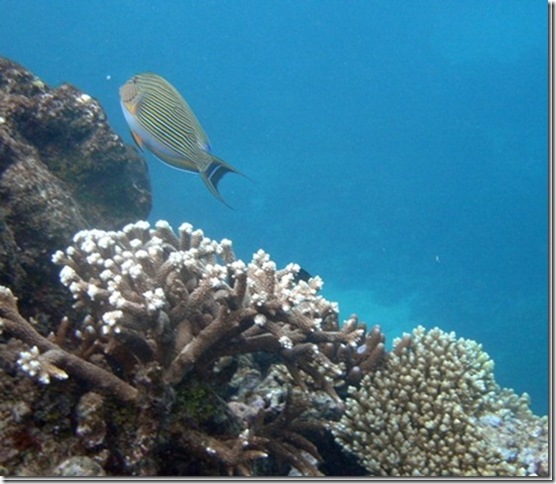 Lots of colorful fish and nice coral
Lots of colorful fish and nice coral
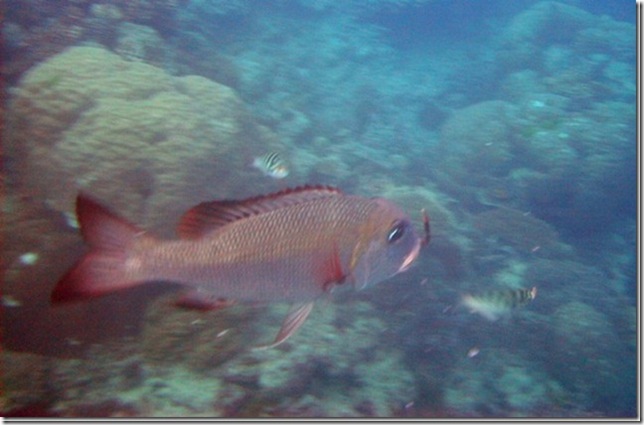 This guy was trying to munch down the rest of the crab before it got stolen right out of his mouth
This guy was trying to munch down the rest of the crab before it got stolen right out of his mouth
Once the tour boat had left, we made our way over to the pontoon and met Wilson. Wilson is from the Solomon Islands and spends four nights a week on the pontoon by himself. It’s his own little island. He showed us around and told us to make ourselves at home, gave us a few tips on where to dive and snorkel, and even told us to grab a couple of cold drinks from the cooler in the restaurant area. We asked if he liked lasanga (there’s still more left) and agreed on a lasagna dinner on the pontoon. The pontoon is set up for all sorts of diving activities and also includes a restaurant area with tables and a sun deck. We walked down into the underwater fish-viewing portion of the pontoon and saw Wally resting under the pontoon, so we lowered one of the diving ladders and walked in to have a closer look. He wasn’t quite as friendly as we’d hoped, but we did get a nice shot of Lauren chasing him. He’s about the size of her torso.
After checking out Wally, we dove out from under the pontoon and headed for the main snorkeling area. Wow! It was easily the best snorkeling we’ve ever seen. The coral was varied and healthy, the water was shallow enough that the visibility and light were good, and there were lots of large, colorful fish, as well as giant clams. The first large creature we saw was a white-tipped reef shark about four feet long. I followed him for a while to video him swimming along, but he seemed to be more interested in getting away from me than in helping me out with a nice video. Next, a really big humphead parrotfish came swimming right toward us. It was at least 3 times the size of the largest parrotfish we’d seen. It’s jaws of fused teeth, looking like the beak of a parrot were open and clearly visible as he swam by. I was following him with the camera taking video when he made a sharp turn and took a such a big bite of coral that you can even here the crunching sound in the video that our low-end underwater camera made.
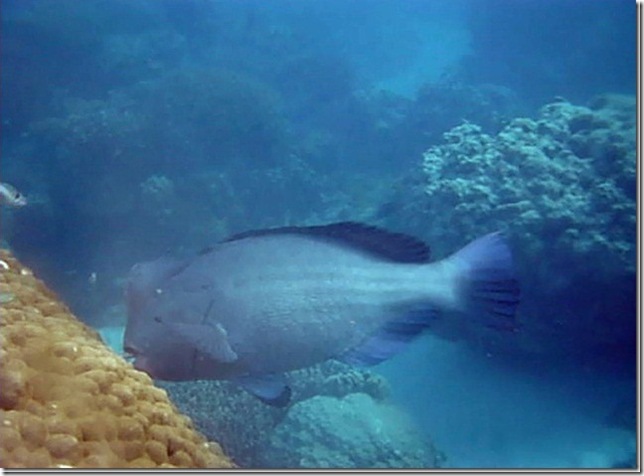 Large humphead parrotfish about to take a big bite of coral
Large humphead parrotfish about to take a big bite of coral
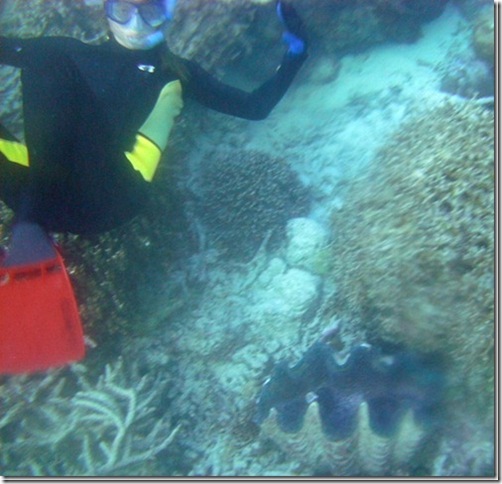 Lauren with a giant clam (they can get to be twice that size)
Lauren with a giant clam (they can get to be twice that size)
We’d really enjoyed snorkeling, but we wanted to try a dive, so we motored over to the spot Wilson had pointed out. I didn’t want to try tying off to dead coral on the top of the “bommie” (giant coral head), so we tied off to a nearby mooring and swam over through the open water. When we got there and dropped down, there were six large barracuda and a fair amount of current waiting for us. By time we reached 20′ or so, two 5-6′ sharks swam by. One was a white-tip and the other was one we haven’t seen before. He was a bit more active and aggressive-looking, with a smaller blue fish that seemed to be stuck to his tail and hitching a ride. Visibility wasn’t great and it was getting near dusk, but we still saw plenty of large fish in the 25-minute trip around the giant head. One of my favorites was a group of fairly large ones that were black with white fan-tails and a growth above their mouth that stuck out like a Pinocchio nose. After seeing the same two sharks again, and completing our trip around, we headed back for the dinghy.
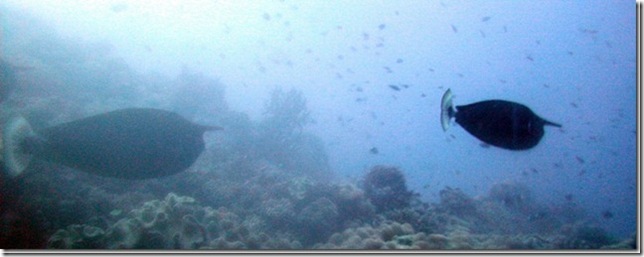 If these aren’t called Pinocchio fish, someone screwed up
If these aren’t called Pinocchio fish, someone screwed up
It was a wet ride back to the boat, but we changed, rinsed the gear, and headed over to see Wilson for dinner, which was really nice. He brought out some cold drinks and we had a nice conversation. Apparently they only take him off the pontoon if it’s going to get a direct hit from a hurricane. He’s stayed on through a couple of hurricanes, but the last one was strong enough that they decided to pull him off. By time the boat was there to get him, though, the waves were breaking onto the second story of the pontoon and the best the boat could do was to wait nearby while Wilson swam out to them through the wind and waves. After dinner we enjoyed a little American television thanks to the magic of satellites and electric generators. It was the first time in over a year that Lauren and I had watched American television together.
Lat: 16 25.886′ S
Long: 145 59.209′ E
We spent longer than we’d planned in Cairns due to bad weather and didn’t get to take friends for a day-sail out to the Reef, but it was good for Dallas and I to have a couple of rainy days to get the boat and ourselves back in order now that the crew has deboarded. It was also really good to catch up with family via Skype. I wish we could have had more time to catch up with friends, but thanks to Facebook, I have a pretty good idea of what they’re up to. Tis the season for weddings back home, and I want to say congrats to our friend and pseudo-sister A.P. for getting hitched (wish we could have been there!) and to the Uden family for the marriage of their daughter, Jenny. A lot has happened in the year and a half that we’ve been away, but technology and solid relationships make it possible for me to feel connected and continue the journey.
As Colin was collecting his things to move ashore on Saturday, an Aussie couple in a dinghy stopped by to let us know that a large (10′?) croc was hanging out on the mudbank beside the nearby mangrove trees. Colin, Dallas, and I thanked them and immediately dropped what we were doing and jumped in our dinghy to take a look. At first we were convinced that what we were seeing was an overturned boat with its long, steely appearance, but then we saw movement of the head. Dallas brought us within 100′ or so, and we could make out every little detail, from the wide, vicious but smiling jaw to the spiky tail. It seemed like it was looking right at us, and indeed, Colin has a photo that shows it looking right at the camera. It was awesome to see but definitely as close as I ever want to get. I’m not one to shy away from scary experiences, but my imagination started to play up when I thought about what that croc could do to our dinghy. I made the mistake of saying my concerns out loud, and Dallas felt compelled to grab my leg when I was looking the other way and make me jump. Maybe I have him to blame for my scary crocodile dream that night!
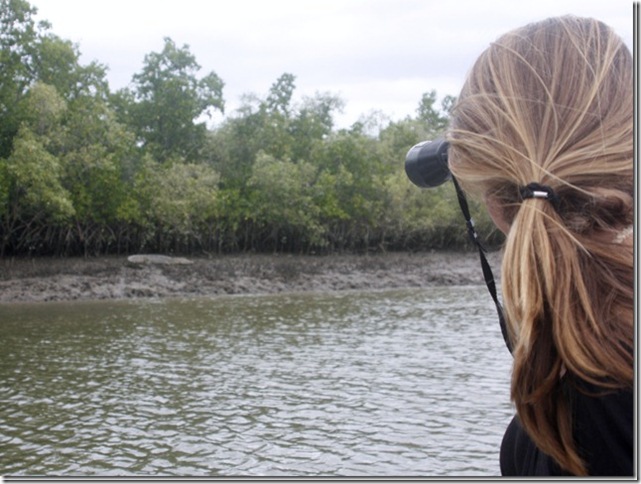 Close enough (Photograph by Colin Murphey – http://www.deadreckoningreports.com)
Close enough (Photograph by Colin Murphey – http://www.deadreckoningreports.com)
Gotta love the zoom lens (Photograph by Colin Murphey – http://www.deadreckoningreports.com)
Cruisers on our route often go straight to Darwin from the Pacific Islands or stop in Papua New Guinea or the Solomon Islands, but I was really excited about the prospect of diving the Great Barrier Reef and voted to add Cairns to the list of stops. We weren’t sure if it was the best option since we’ve done quite a bit of diving already, but after my first experience checking out the Reef, I think we made a good choice….
We pulled the anchor out of the thick mud early this morning and managed to break the windlass. Hopefully it’s nothing too serious. We then sailed in 25-30 knots of wind to Norman Reef. As the Great Barrier Reef as a whole is massive, bigger than Kansas in fact, it is hard to know where to go for the best diving, but Norman was recommended by some Aussies at the marina. Also, Dallas was able to find GPS coordinates and descriptions of all of the Barrier Reef dive sites online, so we are using those to inform our decisions about where to go.
We arrived at the one public mooring near the reef around 3:00 p.m. and were happy to find that it was available. (Anchoring at Norman isn’t feasible, so if someone had been on the mooring, we’d have had to just keep sailing, possibly through the night.) It was windy and overcast, but I wanted to get some snorkeling in before the day was done. (Meanwhile Dallas started making some yummy lasagna, his new specialty.) The current wasn’t too bad despite the strong winds, and I swam over to some large, colorful coral heads a quarter mile or so from the boat. I was immediately impressed by the number of large fish. The parrot fish were about 3x bigger than the ones I’m used to seeing, and there were plenty of other large fish as well. I watched a small sea turtle make a nose dive and paddle itself right by me. Just as I started to head back to the boat after realizing that it was getting to be dusk, not a time that I want to be alone in the water, I realized that I was swimming directly over a gray-tipped reef shark. He was probably 4′ long but a good distance away and not the least bit interested in me. Nevertheless, I quickened my pace and looked over my shoulder a couple of times on my way back to the boat. I’m looking forward to seeing what tomorrow brings. We’re planning to get at least two dives in here at Norman and, with any luck, see the huge (6′ long?) Maori Wrasse named Wally that hangs out and is fed nearby.
We’ve had the usual first-day fatigue today but are experiencing lots of motion while moored here just behind the reef, so we should have our sealegs by tomorrow (knock on wood). In the meantime, it is rocking us to sl-e-e–p…


